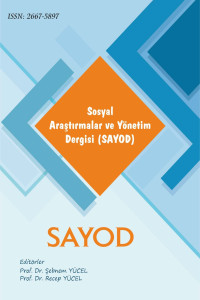Öz
Medicinal and aromatic plants (MAPs) products became more popular during and after the Covid-19 pandemic. MAPs production and marketing could be accepted as a niche business. The purpose of this study is to examine the marketing strategies of a MAPs producing company from Türkiye. Using case study, data is gathered via interviews, observations and secondary sources. Findings showed that the company succeeded a prudent progress in various market segments basing on its market orientation culture and use of different market distribution channels. Every distribution channel had a different market segment as well as a different structure. The company learned from its market experiences and orientation. They had been organizing to enter the USA market as well as exporting to several other countries. The findings point out that in our today’s world of high competition, companies focus on various market segments, follow different pricing and branding strategies simultaneously so that they can survive in a complex environment with a persistent competitive advantage.
Anahtar Kelimeler
Kaynakça
- Bağcı H. and Atasever M. (2020). Türkiye Serbest Eczane Sektör Analizi, Türk Eczacılar Birliği Yayınları, Ankara.
- Batem (2012). Tıbbi ve Aromatik Bitki İşletmelerinin Yapısal Analizi https://arastirma.tarimorman.gov.tr/batem/Belgeler/Kitaplar/t%C4%B1bbi2012%20katalog.pdf (Access Date: 24.08.2021).
- Crowe, S., Cresswell, K., Robertson, A., Huby, G., Avery, A., and Sheikh, A. (2011). The Case Study Approach. BMC Medical Research Methodology, 11(1), 1-9.
- Dobni, C. B., and Luffman, G. (2000). Implementing Marketing Strategy through a Market Orientation. Journal of Marketing Management, 16(8), 895-916.
- Esetlili, B.Ç., Pekcan T., Çobanoğlu Ö., Aydoğdu E., Turan S., and Dilek A. N.A. (2014). Essential plant nutrients and heavy metals concentrations of some medicinal and aromatic plants. Journal of Agricultural Sciences 20 (3), 239-247.
- Heale, R., and Twycross, A. (2018). What is a Case Study?. Evidence-based Nursing, 21(1), 7-8.
- KPMG (2020). Perakende Sektörel Bakış, https://assets.kpmg/content/dam/kpmg/tr/pdf/2020/01/sektorel-bakis-2020-perakende.pdf (Access Date: 14.09.2021).
- Mitchell, R. W., Wooliscroft, B., and Higham, J. (2010). Sustainable Market Orientation: A New Approach to Managing Marketing Strategy. Journal of Macromarketing, 30(2), 160-170.
- Porter, M. E. (1990). New Global Strategies for Competitive Advantage. Planning Review. 18(3), 4-14.
- Sciencedirect (2013). https://www.sciencedirect.com/topics/agricultural-and-biological-sciences/phytotherapy (Access Date: 25.08.2021)
- Schmitt, B., and Zarantonello, L. (2013). Consumer Experience and Experiential Marketing: A Critical Review. Review of Marketing Research. https://doi.org/10.1108/S1548-6435(2013)0000010006, March, 25-61.
- Sharp, B. (1991). Competitive Marketing Strategy: Porter revisited. Marketing Intelligence & Planning, 9(1), 4-10.
- Slater, S. F., Mohr, J. J., and Sengupta, S. (1995). Market Orientation. Journal of Marketing, 59, 63-74.
- Tadepalli, R., and Avila, R. A. (1999). Market Orientation and the Marketing Strategy Process. Journal of Marketing Theory and Practice, 7(2), 69-82.
- The World Bank (2018), https://openknowledge.worldbank.org/bitstream/handle/10986/31613/Medicinal-and-Aromatic-Plants.pdf?sequence=1&isAllowed=y (Access Date: 24.08.2022)
- Varadarajan, R. (2010). Strategic Marketing and Marketing Strategy: Domain, Definition, Fundamental Issues and Foundational Premises. Journal of the Academy of Marketing Science, 38(2), 119-140.
Öz
Medicinal and aromatic plants (MAPs) products became more popular during and after the Covid-19 pandemic. MAPs production and marketing could be accepted as a niche business. The purpose of this study is to examine the marketing strategies of a MAPs producing company from Türkiye. Using case study, data is gathered via interviews, observations and secondary sources. Findings showed that the company succeeded a prudent progress in various market segments basing on its market orientation culture and use of different market distribution channels. Every distribution channel had a different market segment as well as a different structure. The company learned from its market experiences and orientation. They had been organizing to enter the USA market as well as exporting to several other countries. The findings point out that in our today’s world of high competition, companies focus on various market segments, follow different pricing and branding strategies simultaneously so that they can survive in a complex environment with a persistent competitive advantage.
Anahtar Kelimeler
Kaynakça
- Bağcı H. and Atasever M. (2020). Türkiye Serbest Eczane Sektör Analizi, Türk Eczacılar Birliği Yayınları, Ankara.
- Batem (2012). Tıbbi ve Aromatik Bitki İşletmelerinin Yapısal Analizi https://arastirma.tarimorman.gov.tr/batem/Belgeler/Kitaplar/t%C4%B1bbi2012%20katalog.pdf (Access Date: 24.08.2021).
- Crowe, S., Cresswell, K., Robertson, A., Huby, G., Avery, A., and Sheikh, A. (2011). The Case Study Approach. BMC Medical Research Methodology, 11(1), 1-9.
- Dobni, C. B., and Luffman, G. (2000). Implementing Marketing Strategy through a Market Orientation. Journal of Marketing Management, 16(8), 895-916.
- Esetlili, B.Ç., Pekcan T., Çobanoğlu Ö., Aydoğdu E., Turan S., and Dilek A. N.A. (2014). Essential plant nutrients and heavy metals concentrations of some medicinal and aromatic plants. Journal of Agricultural Sciences 20 (3), 239-247.
- Heale, R., and Twycross, A. (2018). What is a Case Study?. Evidence-based Nursing, 21(1), 7-8.
- KPMG (2020). Perakende Sektörel Bakış, https://assets.kpmg/content/dam/kpmg/tr/pdf/2020/01/sektorel-bakis-2020-perakende.pdf (Access Date: 14.09.2021).
- Mitchell, R. W., Wooliscroft, B., and Higham, J. (2010). Sustainable Market Orientation: A New Approach to Managing Marketing Strategy. Journal of Macromarketing, 30(2), 160-170.
- Porter, M. E. (1990). New Global Strategies for Competitive Advantage. Planning Review. 18(3), 4-14.
- Sciencedirect (2013). https://www.sciencedirect.com/topics/agricultural-and-biological-sciences/phytotherapy (Access Date: 25.08.2021)
- Schmitt, B., and Zarantonello, L. (2013). Consumer Experience and Experiential Marketing: A Critical Review. Review of Marketing Research. https://doi.org/10.1108/S1548-6435(2013)0000010006, March, 25-61.
- Sharp, B. (1991). Competitive Marketing Strategy: Porter revisited. Marketing Intelligence & Planning, 9(1), 4-10.
- Slater, S. F., Mohr, J. J., and Sengupta, S. (1995). Market Orientation. Journal of Marketing, 59, 63-74.
- Tadepalli, R., and Avila, R. A. (1999). Market Orientation and the Marketing Strategy Process. Journal of Marketing Theory and Practice, 7(2), 69-82.
- The World Bank (2018), https://openknowledge.worldbank.org/bitstream/handle/10986/31613/Medicinal-and-Aromatic-Plants.pdf?sequence=1&isAllowed=y (Access Date: 24.08.2022)
- Varadarajan, R. (2010). Strategic Marketing and Marketing Strategy: Domain, Definition, Fundamental Issues and Foundational Premises. Journal of the Academy of Marketing Science, 38(2), 119-140.
Ayrıntılar
| Birincil Dil | İngilizce |
|---|---|
| Konular | İşletme |
| Bölüm | Makaleler |
| Yazarlar | |
| Yayımlanma Tarihi | 27 Nisan 2023 |
| Yayımlandığı Sayı | Yıl 2023 Sayı: 1 |


